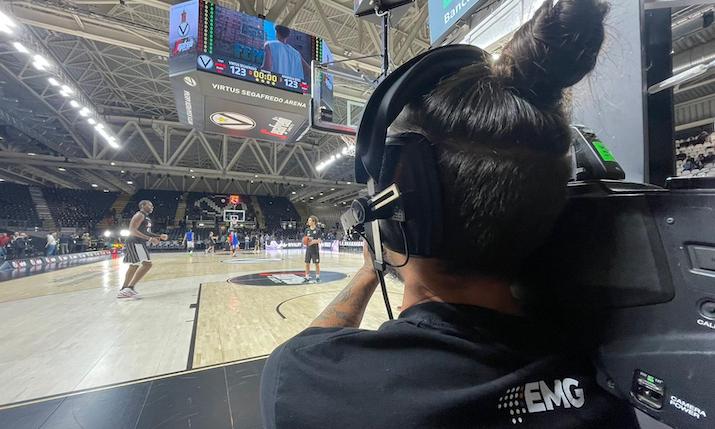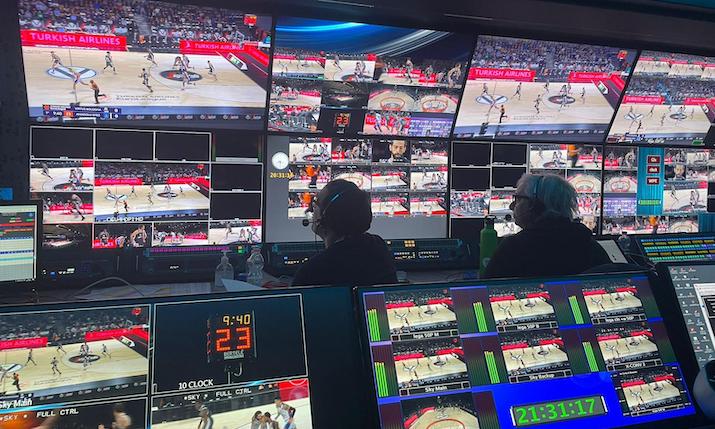Behind the scenes of the EuroLeague and EuroCup with EMG Italy

Fourteen cameras capture the EuroLeague action
EuroLeague basketball, the primary club basketball competition in Europe, features 18 top-level teams from across the region. The tournament unfolds in three phases: the regular season, where points are accumulated through round-robin matches, the playoffs, where the top eight teams compete, and the highly anticipated Final Four, where the four winners compete to be named EuroLeague champion.
Once again, EMG Italy is playing an essential role in the television production of 17 EuroLeague games, ensuring high-quality TV coverage. For the third consecutive year, the group has produced the home games of one of the two Italian teams in the league, Virtus Bologna, in collaboration with Sky Italy; the second Italian team is Olimpia Milano.
The Virtus production involves 14 specialised cameras, each strategically placed to capture all aspects of the games. Ten main cameras cover the on-court actions and the overall gameplay.
The primary camera, 1 main, provides a comprehensive view of the entire court, the second captures close-up shots, detailing on-court actions, bench reactions, and the crowd, while three and four are positioned under the hoops and operated from the shoulder, offering a close-up perspective of the action under the basket, with one of them in super slow motion.
The fifth camera sits in a central position from the centre court to provide a wide and low-angle view, while the beauty camera, number 6, offers a total and spectacular view of the entire arena and is often used as a background for graphics.
Cameras 7 and 8 are micro-cameras placed on the hoops to provide unique angles; camera 9 in a reverse position captures actions from the opposite perspective and reactions of key figures; and camera 10, the ‘clock’, is aimed at the scoreboard and is used to monitor the game’s timer and clock. It serves as an official tool for referees and a backup for the TV production.
An additional camera, positioned on a hi-lo and equipped with a long-range lens, records in 3x Supermotion and offers detailed replays. A further device is located in the flash area and is used for pre- and post-game interviews.
Camera 13 handles press conferences held in a dedicated room and Camera 14 is an aerial drone camera used to capture aerial shots and exterior views of the arena.
Two mobile units in one
EMG Italy uses its Nova 150 OB truck to manage all the aforementioned cameras, with its triple expansion capabilities ensuring a comfortable workspace for the onboard crew.
Introduced in 2020, Nova 150 is a flexible and state-of-the-art vehicle capable of comfortably accommodating up to 34 workstations. It can handle two concurrent productions thanks to two completely separate control rooms and access points, ensuring comprehensive coverage of games for both the international main feed and the national customisation for Sky Italy.

The preparation process for the mobile unit starts the day before each game, with pre-setup. It moves to the match venue on the day of the game and is engaged in long hours of work, from early morning until late at night, to ensure flawless transmission.
A production team of around 30 people is responsible for filming EuroLeague games for Virtus.
Virtus Arena
The home of Virtus is the Virtus Arena, a modern space inside a Bologna trade fair pavilion.
The fibre-optic-wired installation, provided and installed by EMG Italy, is in use throughout the year. EMG Italy serves as the host broadcaster, producing a complete main feed with graphics and advertisements as an international signal for rights holding broadcasters worldwide.
It often handles national integration for Sky Italy as well, leveraging the mobile unit’s ability to manage two concurrent productions through two separate control rooms on the same vehicle, thereby optimising resources.
EuroCup
EMG Italy has also been responsible for the television production of EuroCup games, the second-most prestigious European competition after EuroLeague, for Sky for three years now.
The setup is similar to the EuroLeague, except that there are slightly fewer cameras in use – 11 rather than 14 – and two EVS machines instead of three.
It is still an excellent television production with cameras capturing a significant competition in the European basketball landscape, offering teams and players the opportunity to compete at an international level and demonstrate their skills.
Notably, the team that wins the EuroCup advances to the EuroLeague the following year.

